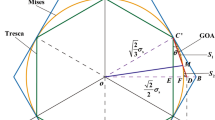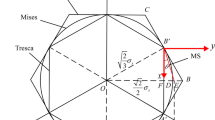Abstract
A new continuous velocity field used to analyze central defect closure for heavy plate rolling is proposed by modifying a two-dimensional velocity field. By using the proposed velocity field and mean yield criterion (or called MY criterion for short), the internal deformation energy rate is obtained. With co-line vector inner-product method, the frictional energy rate is then integrated. Ultimately, an analytical solution of the rolling torque and rolling force is obtained by minimizing the total energy rate with respect to neutral angle. Based on the assumption that when a central defect tends to be closed the stress state coefficient will obtain its critical value, a mathematical expression of critical shape factor together with a dynamic closure criterion for rectangular shape defects are derived. It is found that the critical shape factor is a function of initial plate thickness, relative reduction, work roll radius, and friction factor. The effects of independent rolling parameters such as plate thickness, relative reduction, work roll radius, and friction factor on the critical shape factor are discussed systematically. The results show that the increases in relative reduction, work roll radius and friction factor benefit defect closure, while a large value of initial plate thickness induces central burst formation. In addition, the proposed criterion is validated by comparison with available theoretical results and very good agreement is found.




Similar content being viewed by others
Abbreviations
- \(h_{x} ,h_{m}\) :
-
Half of plate thickness and half of average plate thickness in roll gap
- \(h_{0} ,h_{1}\) :
-
Half of initial and final plate thickness at inlet and outlet, respectively
- \(h_{t}\) :
-
Total average thickness of rolling plate, \(h_{t} = 2h_{m}\)
- \(h_{x}^{{\prime }} ,h_{x}^{{\prime \prime }}\) :
-
The first and second order derivatives of \(h_{x}\)
- h :
-
Plate thickness
- \(h_{{\alpha_{n} }}\) :
-
Half of plate thickness at the location of neutral point
- \(l_{0} ,l\) :
-
Contact lengths without central defect and with central defect, respectively
- b :
-
Plate width
- \(\theta\) :
-
Bite angle
- \(\sigma_{s}\) :
-
Yield stress
- k :
-
Yield shear stress
- \(v_{x} ,v_{y} ,v_{z}\) :
-
Velocity components in x, y, z directions
- \(\dot{\varepsilon }_{ij}\) :
-
Strain rate
- \(D\left( {\dot{\varepsilon }_{ij} } \right)\) :
-
Specific plastic work rate
- \(x_{a} ,x_{b}\) :
-
Vertical distances between the central defect and the entry section
- \(\Delta h\) :
-
Half of absolute reduction
- \(v_{R}\) :
-
Roll circumferential velocity
- \(\tau_{f}\) :
-
Frictional shear stress on plate surface
- \(\Delta v_{f}\) :
-
Discontinuous quantity of tangential velocity
- \(v_{0}\) :
-
Inlet velocity of plate
- \(\alpha ,\beta ,\gamma\) :
-
Direction angles formed by \(\tau_{f}\) and the coordinate axes in x, y, z directions, respectively
- \(N_{d}\) :
-
Internal strain energy rate
- \(N_{f}\) :
-
Friction energy rate
- \(N_{s}\) :
-
Shear energy rate
- \(U\) :
-
Flow volume per second of deformation part
- \(\alpha_{n}\) :
-
Neutral angle
- \(x_{n}\) :
-
Location of neutral point, \(x_{n} = l - R\sin \alpha_{n}\)
- \(\varPhi\) :
-
Total energy rate
- \(M_{\hbox{min} }\) :
-
Minimum value of roll torque
- \(F_{\hbox{min} }\) :
-
Minimum value of separating force
- \(n_{\sigma }\) :
-
Stress state coefficient
- m :
-
Friction factor
- χ :
-
Lever arm ratio
- \(\Delta ,\Delta_{c}\) :
-
Actual and critical shape factors
- r :
-
Relative reduction
References
Stählberg U, Keife H, Lundberg M (1980) A study of void closure during plastic deformation. J Mech Work Technol 4(1):51–63
Wallerö Anders (1985) Closing of a central longitudinal pore in hot rolling. J Mech Work Technol 12(2):233–242
Wang A, Thomson PF, Hodgson PD (1996) A study of pore closure and welding in hot rolling process. J Mater Process Technol 60(1–4):95–102
Pietrzyk M, Kawalla R, Pircher H (1995) Simulation of the behavior of internal porosity study on application of limit analysis to rolling process. Steel Res 66:522–529
Ervasti E, Stählberg U (2000) Transversal cracks and their behaviour in the hot rolling of steel stabs. J Mater Process Technol 101(1–3):312–321
Nakasaki M, Takasu I, Utsunomiya H (2006) Application of hydrostatic integration parameter for free-forging and rolling. J Mater Process Technol 177(1–3):521–524
Banaszek G, Stefanik A (2006) Theoretical and laboratory modelling of the closure of metallurgical defects during forming of a forging. J Mater Process Technol 177(1–3):238–242
Ji YH, Park JJ, Moon CH et al (2009) Finite element analysis of deformation characteristics in heavy slab rolling. Int J Mod Phys B 23:1591–1596
Park JJ (2011) Prediction of void closure in a slab during various deformation processes. J Mech Sci Technol 25(11):2871–2876
Turczyn S (1996) The effect of the roll-gap shape factor on internal defects in rolling. J Mater Process Technol 60:275–282
Ono SI, Minami K, Murai E, Iwadate T (1994) Three-dimensional simulation on the internal void closure in an ultra-large ingot using a pre-cooling forging process. J Jpn Soc Technol Plast 35:1201–1206
Överstam H, Jarl M (2004) FEM-simulation of drawing out in open die forging. Steel Res Int 75:812–817
Zhang XX, Cui ZS, Chen W, Li Y (2009) A criterion for void closure in large ingots during hot forging. J Mater Process Technol 209(4):1950–1959
Deng W, Zhao DW, Qin XM et al (2009) Simulation of central crack closing behavior during ultra-heavy plate rolling 47(2):439–447
Kakimoto H, Arikawa T, Takahashi Y et al (2010) Development of forging process design to close internal voids. J Mater Process Technol 210(3):415–422
Chen K, Yang Y, Liu K et al (2010) Simulation of void defect evolvement during the forging of steel ingot. Adv Mater Res 97–101:3079–3084
Lee YS, Lee SU, Van Tyne CJ et al (2011) Internal void closure during the forging of large cast ingots using a simulation approach. J Mater Process Technol 211(6):1136–1145
Chen J, Chandrashekhara K, Mahimkar C et al (2011) Void closure prediction in cold rolling using finite element analysis and neural network. J Mater Process Technol 211(2):245–255
Chen K, Yang YT, Shao GJ et al (2012) Strain function analysis method for void closure in the forging process of the large-sized steel ingot. Comput Mater Sci 51(1):72–77
Chen K, Liu KJ, Chen HF et al (2014) A criterion for void closure in the porous model during the forging of steel ingot and its application. Comput Mater Sci 91:303–309
Chen MS, Lin YC (2013) Numerical simulation and experimental verification of void evolution inside large forgings during hot working. Int J Plast 49:53–70
Yu HL, Kiet Tieu A, Liu C et al (2014) Investigation of closure of internal cracks during rolling by FE model considering crack surface roughness. Int J Adv Manuf Technol 75(9–12):1633–1640
Li GS, Yu W, Cai QW (2015) Investigation of the evolution of central defects in ultra-heavy plate rolled using gradient temperature process. Metall Mater Trans B 46(2):831–840
Wang B, Zhang JM, Xiao C et al (2015) Analysis of the evolution behavior of voids during the hot rolling process of medium plates. J Mater Process Technol 221:121–127
Joo SH, Jung JY, Chun MS et al (2014) Finite element and experimental analysis of closure and contact bonding of pores during hot rolling of steel. Metall Mater Trans A 45(9):4002–4011
Yu HL, Liu XH, Li XW et al (2014) Crack healing in a low-carbon steel under hot plastic deformation. Metall Mater Trans A 45(2):1001–1009
Chen MS, Lin YC, Chen KH (2014) Evolution of elliptic-cylindrical and circular-cylindrical voids inside power-law viscous solids. Int J Plast 53:206–227
Feng C, Cui ZS (2015) A 3-D model for void evolution in viscous materials under large compressive deformation. Int J Plast 74:192–212
Zhao DW, Zhang SH, Wang GJ et al (2011) Deduction of critical condition of central void defect closure for heavy plate in hot rolling and its application. Chin J Appl Mech 28(6):658–662 (in Chinese)
Zhao DW, Liu XH, Wang GD (2002) Yield criterion based on the mean function of Tresca and twin shear stress yield functions. J Northeast Univ 23:976–981 (in Chinese)
Harris JN (1983) Mechanical working of metals, theory and practice, 1st edn. A. Wheaton & Co, Exeter
Chen QJ, Kang YL, Hong HP et al (2005) Simulation of rolling process for wide and thin plate of alloy steel by finite element method. J Plast Eng 12:163–167
Acknowledgments
The authors wish to acknowledge the National Natural Science Foundation of China (Grant No. 51504156), the Basic Research Program of Jiangsu Province (Grant No. BK20140334), the Natural Science Foundation of the Jiangsu Higher Education Institutions of China (Grant No. 14KJB460024) and the Project Funded by China Postdoctoral Science Foundation (Grant No. 2014M561707). The authors also wish to acknowledge valuable suggestions from reviewers.
Author information
Authors and Affiliations
Corresponding author
Rights and permissions
About this article
Cite this article
Zhang, S.H., Chen, X.D., Zhou, J. et al. A dynamic closure criterion for central defects in heavy plate during hot rolling. Meccanica 51, 2365–2375 (2016). https://doi.org/10.1007/s11012-016-0371-9
Received:
Accepted:
Published:
Issue Date:
DOI: https://doi.org/10.1007/s11012-016-0371-9




